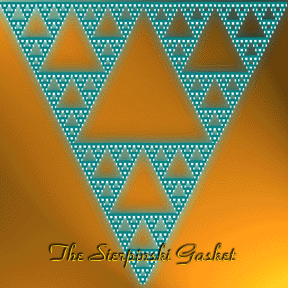 The Sierpinski Gasket, the blue part of
the picture, is an example of a fractal. It is self-similar. So,
a piece of it under a microscope would look the same as the whole
gasket.
The Sierpinski Gasket, the blue part of
the picture, is an example of a fractal. It is self-similar. So,
a piece of it under a microscope would look the same as the whole
gasket.| ..The Sierpinski Gasket and Transformations.. |
 The Sierpinski Gasket, the blue part of
the picture, is an example of a fractal. It is self-similar. So,
a piece of it under a microscope would look the same as the whole
gasket.
The Sierpinski Gasket, the blue part of
the picture, is an example of a fractal. It is self-similar. So,
a piece of it under a microscope would look the same as the whole
gasket.
You can imagine
that it was made by cutting triangular holes out of a large blue
triangle. But let's look at it some other ways, and see how to
use linear transformations to draw it rather quickly.
If you have a graphics program such as Photoshop or The Gimp that allows you to scale an image, you can make a gasket, too. If not, just watch. First, make a colored square as in frame 1 below. Then scale it down by 1/2 in each direction to get the smaller square in frame 2. [You just did a linear transformation]. Next translate the square in three different ways to get frame 3. [These 3 transformations are not actually linear, because the origin is moved. Unless you use "homogeneous coordinates" (see the computer graphics section of the text)]. Now repeat the scaling and the 3 translations to go from frame 3 to frame 4.
 |
 |
 |
 |
Then, repeat those same steps over and over, to
get the frames below. [I accidentally skipped one - can you find
it?]. I stopped at the 8th frame, and rescaled and decorated a
little bit, to get the picture at the top of the page. What would
happen if we went on to 9, 10, 11, etc? Well, the picture loses
25 percent of its color at every stage (compare frames 1 and 3,
then 3 and 4, etc). So, the picture would gradually fade out.
But mathematicians know that there are some points left over
"at the end" and these form the true gasket. It
includes all the one-dimensional diagonal lines (at least). What
is the "dimension" of the gasket? Well, this word
doesn't have exactly the same meaning as in Linear Algebra, and
for fractals, it can be a number between 1 and 2!
 |
 |
 |
 |
What if we change the 3 transformations? Replace the three squares in frame 3 by three tilted parallelograms, for example? Instead of the Sierpinski gasket, these shapes can arise:
 |
 |
 |
I wrote a simple program (about 20 lines in BASIC) to produce these. It draws the same object that our 8-step method would have, but it uses a different algorithm. It draws one point, then applies one of the 3 transformations (chosen at random), to decide on the next point to draw. It then repeats, about 100,000 times. To see a super-fast version of this in the third frame above, click your browser's reload button. With some trial and error, you can make Christmas trees, ferns, etc. and watch them grow.
There is an amazing connection between the Sierpinski gasket and Pascal's triangle. If you make a big one, erase the even numbers in it, and stand way back, you'll see triangular holes that look exactly like the ones in the gasket (turned upside-down).
|
 |
Pascal's Triangle (first 7 rows only!) - Compare with the top of the gasket.
Each number is the sum of the two closest ones above it, and is a binomial coefficient (see the binomial theorem, from Calculus Two, or Discrete Math). You can compute a few more rows to see more of the pattern.
If you are interested in knowing more, you might read up on the Cantor Set, which is a simpler fractal than the Sierpinski gasket. For programming help, see reference 1) below. For lots of wild pictures and more mathematical connections, see 2). Also, some people have even studied differential equations on the gasket, but that's pretty advanced stuff.
1) "Math Projects in the Computer Age" by David Thomas, Franklin Watts NY, 1995.
2) "Computers and the Imagination", Clifford A Pickover, St Martin's Press NY, 1991.